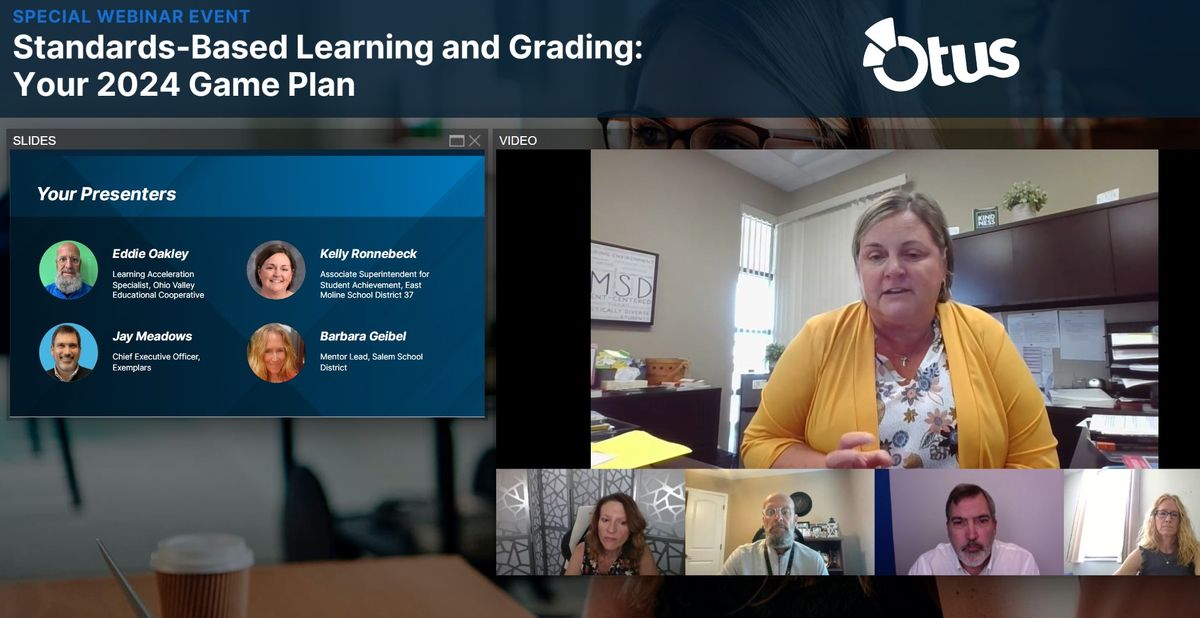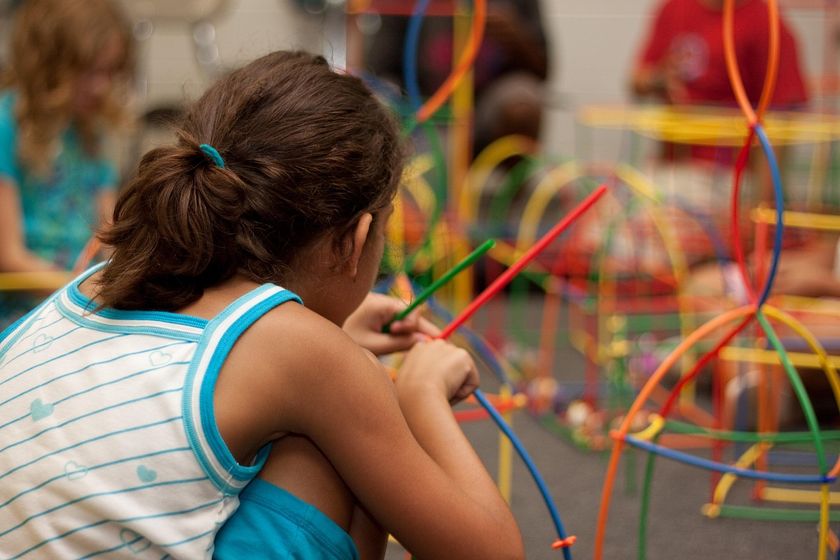Standards-Based Learning and Grading: Your 2024 Game Plan
What to know when implementing standards-based learning into your district

The movement toward standards-based learning has been in motion for over 30 years, yet there is still widespread confusion about why this model is so valuable.
During a recent Tech & Learning roundtable webinar sponsored by Otus, a panel of K-12 leaders tackled the most pressing questions about standards-based learning and grading, and shared how to prepare to address it in the new school year.
Watch the full webinar on demand here.
Panelists included:
- Eddie Oakley, Learning Acceleration Specialist, Ohio Valley Educational Cooperative, Kentucky
- Kelly Ronnebeck, Associate Superintendent for Student Achievement, East Moline School District 37, Illinois
- Jay Meadows, Chief Executive Officer, Exemplars
- Barbara Geibel, First Grade Teacher, Mentor Lead, Salem School District, Wisconsin

What are the core principles of your district’s standards-based grading, and how do you implement and provide feedback to support these?
Kelly Ronnebeck: “We found that standards-based systems’ grading really focuses on student learning of the core content, not on engagement or the student’s effort. We really liked that, and we were able to show parents where their students were performing in relation to the standard. It really aligns more closely to what we’re doing in the classroom with our instructional practices, and provides a more specific, accurate, and more understandable description of what students are doing.”
Barbara Geibel: “Last year is when we started meeting as grade levels and going through all our standards, picking out our essential standards and the ones we thought were most important, and then started aligning our assessments and building our report cards from that.”
Jay Meadows: “Looking at it through the lens of a math teacher, I realized that our grading practices weren’t really asking our students to think about 21st-century real-world problems and how to solve those while developing 21st-century skills . . . The traditional report card wasn’t really [reflecting those skills]. I was giving students As and Bs on tests for procedural fluency that my phone can do now. So what should we be asking kids to do in our math classrooms? When we think about math a little bigger, beyond procedures and algorithms, and encourage problem-solving and critical thinking, it’s more engaging and in alignment with 21st-century needs.”
Tech & Learning Newsletter
Tools and ideas to transform education. Sign up below.
Eddie Oakley: “Focusing on the priority standards, and staying away from ‘the efforts’ and extra credit, really let us know where students are, and what they can and cannot do.”
What steps have you taken to align curriculum, assessments, and instruction to standards-based grading?
Geibel: “We worked together to make sure that our assessments were aligned to the state standards, and we used Otus to put that all in to make sure of the accountability and consistency so that we’re all on the same page . . . In the beginning, you have some who are leery about it – it’s something different, right?”
Ronnebeck: “Standards-based grading really helped us give true pictures to parents and teachers and students, especially since we have such a diverse population. It was a big shift, but our teachers were very excited about it because they felt that disconnect between what we were doing with instruction and matching that with a letter grade . . . We started the learning as a group, doing various book studies looking into standards-based grading, what is it, etc. And then from there, we had various curriculum committees working together, which had representation from all the different grade levels, so we were hearing all the voices across the district, which helped with the buy-in.”
Oakley: “We started with the end in mind. We built our summative assessments first, and then built toward the standards . . . Our district has built a portrait of a graduate, which tells every parent what a student should be able to do at the end of each grade level before going on to the next grade level. It took a lot of work all across the district, and featured a big committee with staff, teachers, community members, and parents. The profile features six pieces to it: global citizen, lifelong learner, inspired innovator, critical thinker, responsible collaborators, effective communicators. Each student in 5th, 8th, and 12th grade has to do a defense of learning to see if they can go across to the next grade level.”
Meadows: “When you start with your assessments, you can work backward. You can say, ‘If these are the expectations, the big ideas, then how can we learn to do that in my classrooms?’ And then that drives a lot of conversations in your PLCs and PD . . . So when you ask students to think about math beyond procedural fluency, it really increases the engagement levels of students. When students are given the freedom to solve a cool problem any way they want, it increases student engagement and freedom in the math classroom . . . So when you do that, you create a consistent set of expectations from K through high school that certain big ideas will be covered every year. And it can take three years for everyone to buy in and see math the same way, and that consistency is the key to standards-based learning. It takes time, but it’s a powerful journey.”
Oakley: “Assessments and instruction both need to be rigorous. And I told my students and teachers that the practice is going to be harder than the game. So taking tough assessments gives them the confidence when it’s time to take the state exams.”
How are you communicating to parents? Learning expectations, grading policies, etc.
Oakley: “It first started with getting the staff on board, and then went to families. I wrote letters to parents, and said, ‘When you were in school, grades were 70%, 80%, etc.,’ and I asked them to tell me what that meant. And they couldn’t tell me what it meant. Now with standards-based grading, their students can tell them what that means because they’ve mastered the standard . . . Now we’re using social media to get things out to students and parents.”
Geibel: “We’re just going to be starting it, so it’s been a lot of communication to start out. It’s starting with early grades first. This will be a breath of fresh air because it can show the parents exactly what their student does and does not know . . . By starting with K-2, they will move up through the grades to help with the adoption/switch.”
Ronnebeck: “It’s a very slow rollout. We started with our K-4 buildings, which are self-contained classrooms. We had a gentle start with traditional grades, but changed some other parts. We worked with the mindset at middle school the first year, but we’re also holding town hall meetings, sending home notes, flyers, social media, etc. We also had a short video at every event that scrolled through it over and over again, giving the highlights of standards-based grading . . . A lot of the communication has really happened through conversation, but with the students talking to their parents, but it’s also discussed in teacher conferences, which rolls into the instruction. So having those direct discussions with parents was really the game-changer. Change is scary!”
Ray Bendici is the Managing Editor of Tech & Learning and Tech & Learning University. He is an award-winning journalist/editor, with more than 20 years of experience, including a specific focus on education.











